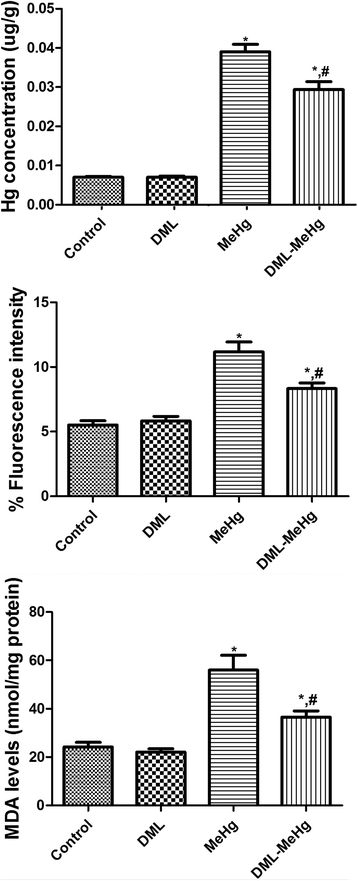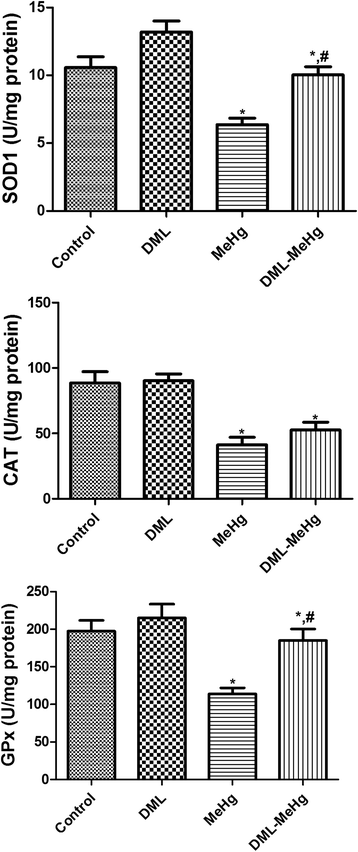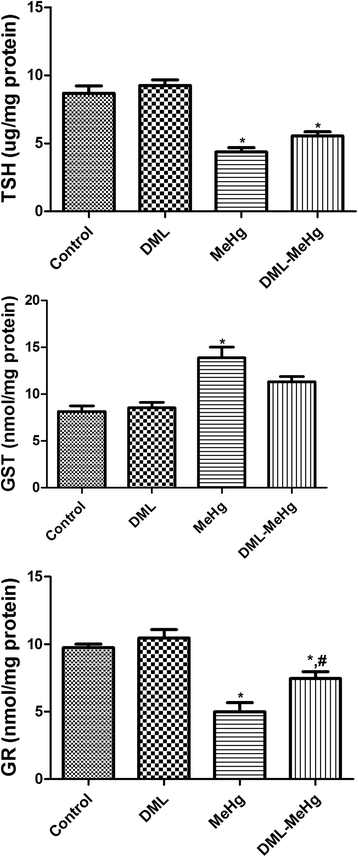Antioxidant effects of Dendropanax morbifera Léveille extract in the hippocampus of mercury-exposed rats
- PMID: 26201852
- PMCID: PMC4511420
- DOI: 10.1186/s12906-015-0786-1
Antioxidant effects of Dendropanax morbifera Léveille extract in the hippocampus of mercury-exposed rats
Abstract
Background: Dendropanax morbifera Léveille has been employed for the treatment of infectious diseases using folk medicine. In this study, we evaluated the antioxidant effects of a leaf extract of Dendropanax morbifera Léveille in the hippocampus of mercury-exposed rats.
Methods: Seven-week-old Sprague-Dawley rats received a daily intraperitoneal injection of 5 μg/kg dimethylmercury and/or oral Dendropanax morbifera Léveille leaf extract (100 mg/kg) for 4 weeks. Animals were sacrificed 2 h after the last dimethylmercury and/or leaf extract treatment. Mercury levels were measured in homogenates of hippocampal tissue, a brain region that is vulnerable to mercury toxicity. In addition, we measured reactive oxygen species production, lipid peroxidation levels, and antioxidant levels in these hippocampal homogenates.
Results: Treatment with Dendropanax morbifera Léveille leaf extract significantly reduced mercury levels in hippocampal homogenates and attenuated the dimethylmercury-induced increase in the production of reactive oxygen species and formation of malondialdehyde. In addition, this leaf extract treatment significantly reversed the dimethylmercury-induced reduction in the hippocampal activities of Cu, Zn-superoxide dismutase, catalase, glutathione peroxidase, and glutathione-S-transferase.
Conclusion: These results suggest that a leaf extract of Dendropanax morbifera Léveille had strong antioxidant effects in the hippocampus of mercury-exposed rats.
Figures



Similar articles
-
The Clinical Effects of Dendropanax Morbifera on Postmenopausal Symptoms: Review Article.J Menopausal Med. 2017 Dec;23(3):146-155. doi: 10.6118/jmm.2017.23.3.146. Epub 2017 Dec 29. J Menopausal Med. 2017. PMID: 29354613 Free PMC article. Review.
-
Dendropanax Morbiferus and Other Species from the Genus Dendropanax: Therapeutic Potential of Its Traditional Uses, Phytochemistry, and Pharmacology.Antioxidants (Basel). 2020 Oct 8;9(10):962. doi: 10.3390/antiox9100962. Antioxidants (Basel). 2020. PMID: 33049991 Free PMC article. Review.
-
Leaf extracts from Dendropanax morbifera Léveille mitigate mercury-induced reduction of spatial memory, as well as cell proliferation, and neuroblast differentiation in rat dentate gyrus.BMC Complement Altern Med. 2019 May 2;19(1):94. doi: 10.1186/s12906-019-2508-6. BMC Complement Altern Med. 2019. PMID: 31046739 Free PMC article.
-
Dendropanax morbifera Léveille extract facilitates cadmium excretion and prevents oxidative damage in the hippocampus by increasing antioxidant levels in cadmium-exposed rats.BMC Complement Altern Med. 2014 Oct 31;14:428. doi: 10.1186/1472-6882-14-428. BMC Complement Altern Med. 2014. PMID: 25362479 Free PMC article.
-
Effects of Dendropanax morbifera Léveille extracts on cadmium and mercury secretion as well as oxidative capacity: A randomized, double-blind, placebo-controlled trial.Biomed Rep. 2016 May;4(5):623-627. doi: 10.3892/br.2016.623. Epub 2016 Mar 4. Biomed Rep. 2016. PMID: 27123258 Free PMC article.
Cited by
-
The Clinical Effects of Dendropanax Morbifera on Postmenopausal Symptoms: Review Article.J Menopausal Med. 2017 Dec;23(3):146-155. doi: 10.6118/jmm.2017.23.3.146. Epub 2017 Dec 29. J Menopausal Med. 2017. PMID: 29354613 Free PMC article. Review.
-
Development and Validation of a HPLC-UV Method for Extraction Optimization and Biological Evaluation of Hot-Water and Ethanolic Extracts of Dendropanax morbifera Leaves.Molecules. 2018 Mar 13;23(3):650. doi: 10.3390/molecules23030650. Molecules. 2018. PMID: 29534045 Free PMC article.
-
Dendropanax Morbiferus and Other Species from the Genus Dendropanax: Therapeutic Potential of Its Traditional Uses, Phytochemistry, and Pharmacology.Antioxidants (Basel). 2020 Oct 8;9(10):962. doi: 10.3390/antiox9100962. Antioxidants (Basel). 2020. PMID: 33049991 Free PMC article. Review.
-
Rapid green synthesis of silver and gold nanoparticles using Dendropanax morbifera leaf extract and their anticancer activities.Int J Nanomedicine. 2016 Aug 10;11:3691-701. doi: 10.2147/IJN.S97181. eCollection 2016. Int J Nanomedicine. 2016. PMID: 27570451 Free PMC article.
-
Leaf extracts from Dendropanax morbifera Léveille mitigate mercury-induced reduction of spatial memory, as well as cell proliferation, and neuroblast differentiation in rat dentate gyrus.BMC Complement Altern Med. 2019 May 2;19(1):94. doi: 10.1186/s12906-019-2508-6. BMC Complement Altern Med. 2019. PMID: 31046739 Free PMC article.
References
-
- Lucena GM, Prediger RD, Silva MV, Santos SN, Silva JF, Santos AR, Azevedo MS, Ferreira VM. Ethanolic extract from bulbs of Cipura paludosa reduced long-lasting learning and memory deficits induced by prenatal methylmercury exposure in rats. Dev Cogn Neurosci. 2013;3:1–10. doi: 10.1016/j.dcn.2012.08.003. - DOI - PMC - PubMed
Publication types
MeSH terms
Substances
LinkOut - more resources
Full Text Sources
Other Literature Sources
Medical

